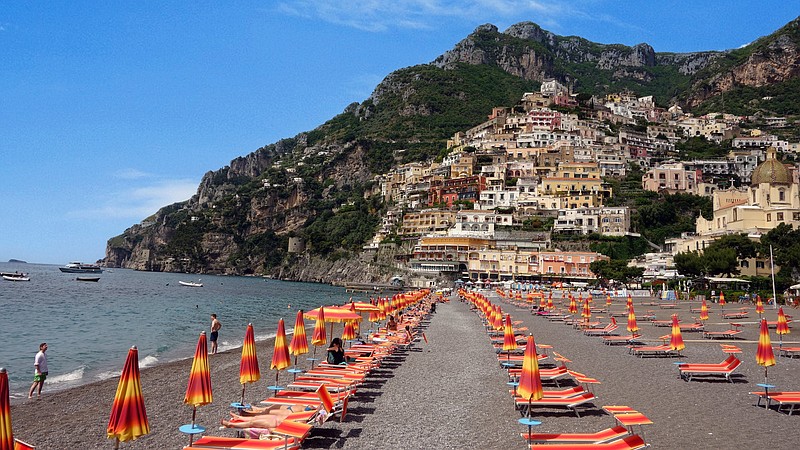For most, Positano is simply the most romantic and chic stop on Italy's Amalfi Coast. South of Naples, the famous coast is blessed with beaches, sunshine, and picturesque towns spilling down steep hillsides. Many who visit Positano want only to shop and lay on the beach. But the tour guide in me simply must put a little historic and cultural meat on your visit.
"Downtown Positano" gathers around a single pedestrian street, tumbling past fine shops and restaurants down to a delightful beach. While Positano's ceramic and linen industries (Moda Positano) date from the 1950s, they boomed when tourists discovered the village in the 1970s. Today you'll find lots of these shops on this street, along with galleries featuring the work of local artists (and an abundance of much-used ATM machines).
Another cottage industry is sandal making. Local artisans craft leather sandals to order while you wait — a Positano tradition. You drop into a shop, select your design and color, and get measured. The craftsman makes the sandals, checks the fit, and sends you off with a wearable souvenir in 10 minutes' time. (If I'm hungry, I'll stroll in my new sandals over to the wonderful Delicatessen to pick up a picnic to go.)
You'll also see La Zagara, a pastry shop with a welcoming terrace. Tempting delicacies such as "baba" (soaked in rum — a local favorite) fill the window display. Across the lane, Hotel Palazzo Murat fills what was once a grand Benedictine monastery.
Walking past the gauntlet of local artisans displaying their goodies, you come to the Church of Santa Maria Assunta, originally the abbey of Positano's 10th-century Benedictine monastery. Built in the Romanesque style, it was abandoned — along with the lower town — when pirates ruled. In the 18th century, when the coast was clear, the church got an extreme Baroque makeover. Inside is a fine manger scene — popular in Italian churches — with its original 18th-century figurines dressed in folk costumes of the age.
The Black Madonna icon-like painting above the altar was likely brought here by Benedictine monks in the 12th century. But locals prefer their romantic legend: Turkish (or Saracen) pirates had it on their ship as plunder. A violent storm hit; it was sure to sink the evil ship. Then the painting of Mary spoke, saying "Posa, posa" ("Lay me down"), and the ship glided safely into this harbor. The pirates were so stricken they became Christians. Locals kept the painting and the town became known as "Posa-tano" (after Mary's command).
Walking around the church, you come to the entry of an underground Roman exhibit. This spot was the site of a Roman villa buried during the eruption of Mount Vesuvius in 79 AD. Only part of the villa has been excavated, but a small museum provides views of a surviving fragment of a large Roman fresco.
The church above, with its colorful, glazed, Majolica-tile dome, faces a tiny square and the beach. Once Positano was a notable naval power with shipyards along this beach. These eventually became fishermen's quarters and then today's tourist restaurants. Roofs all around town have the region's characteristic white domes filled with sand, a low-tech form of insulation that keeps homes warm in winter and cool in summer.
The Positano beach is mostly private (and will cost you a pretty penny for a lounge chair, umbrella, shower facilities, and drink service). As is the case with private beaches anywhere along the Mediterranean, whether you use the gear for 10 minutes or 10 hours, the price is the same.
Come back in the evening, when the beach becomes the gathering point for local boys trying to hustle tourist girls into the chic Music on the Rocks nightclub. This club is all that's left of the 1970s disco scene when Positano really rocked. While nothing is happening until about 11 p.m., it's open for drinks much earlier. Even those not ensnared in the charms of a local Romeo can appreciate its cool, "troglo-disco" interior while sipping a pricey cocktail.
Now that you've toured the town, leave the tourists and the hustlers for a well-deserved break. Follow the locals who hike 10 minutes from the touristy main beach, past a 13th-century fort from pirate days, to enjoy the humble — and cheaper — Fornillo Beach. Settle in, and savor a delightful dose of Mediterranean splendor.
Rick Steves writes European guidebooks, hosts travel shows on public TV and radio, and organizes European tours. This column revisits some of Rick's favorite places over the past two decades. You can email Rick at rick@ricksteves.com and follow his blog on Facebook.
